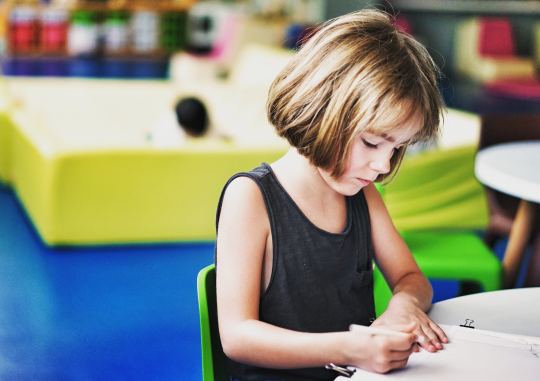There’s one thing we know to be true, and it’s that the best writers are avid readers.
It’s a fact that’s been proven time and time again, and one of the main reasons we ensure that our curriculum includes a healthy balance of both. We do our best to weave the two together, to make the pairing seamless, so our students are building both skills at the same time. One thing we notice, though, is how quickly kids take to reading and how resistant they can be towards writing. We understand — writing requires flexing a different, yet still auxiliary, muscle. It also engages a child’s creative thinking, which can sometimes take a bit of nudging to incite. So how do you do it? How do you make writing fun?
Find a space that is both comfortable and inspiring.
Wise Wonder’s reading and writing corners are inviting while still being filled to the brim with books, knick-knacks, and more. These additions to the space can stimulate a child’s imagination and get them more excited about the task at hand.
Allow each student to ease their way into the process.
Especially when it comes to proper spelling, punctuation, and overall grammar usage. We incorporate phonetic spelling when first introducing more advanced writing prompts to allow children to focus on the prompt itself, rather than if they’re writing correctly. This technique also helps with reading, as children begin to have a deeper sense of phonemic awareness through sounding out and blending sounds independently.
Give them the freedom to explore.
The most effective way to open a child up to writing is to allow them to pick the topic. We like to invite our students to answer writing prompts with fictional answers, so they can really get those gears turning. If a child is given the opportunity to create a totally unique universe that excites them — one with miniature dragons, maybe, or iridescent unicorns — they are typically more willing to actively engage.
Ask open-ended questions.
If a child is stuck on a prompt, their instinct is to say, “I don’t know” or “I can’t do it.” When this issue arises, help them dig a bit deeper by asking questions they may not have thought to ask themselves. Do they like or dislike the topic they’re discussing? What does their character want? What is their favorite part about the story itself? This not only helps them open their minds a bit, but also to think more critically and explore more fully.
And, as always: read, read, read.
And when reading, explore the text at hand. Point out the bigger words, draw attention to descriptive passages, consider the choices certain characters are making and discuss why they were important. This type of close reading gives kids the chance to really observe an author’s style and begin to understand writing more deeply. When children form a relationship with words and stories, the art of storytelling itself becomes something exciting rather than daunting.
Developing a respect for reading and writing at a young age creates deep thinkers and well-rounded learners — qualities that will allow students to reach great heights throughout their education. So open a book, present a blank page, and invite your little ones on a journey — there are always new worlds to discover.

